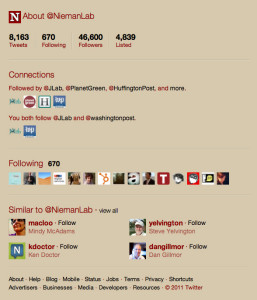Part 3
Following the right people
One of the keys to effective listening on Twitter is figuring out the right people to listen to. Who are the thought leaders, the active tweeters, and the engaged locals in your area, niche or industry? Those are the people you should follow.
Use Twitter’s search function, Twellow and Wefollow to find people and topics to follow relevant to your subject.

The right side of a Twitter page shows connections, including recommendations for other people to follow.
WeFollow is a directory to which almost one million Twitter users have chosen to add themselves by location, topic, or profession. A search on Oakland, CA for example, brings up a tabbed page that offers Twitter accounts by Most Followers and by Most Influential (Most retweeted).
As a self-directed service, however, the data isn’t always accurate. You will notice information for http://wefollow.com/twitter/oakland and http://wefollow.com/city/oakland_ca/followers is completely different.
Another site to check for local users is Twitterholic, which does not rely on self-selection. If you’re in a metro area, try using this to see who are the most followed Tweeters in your region – and then consider following them.
The easiest way to see Twitterholic’s local search stats since they no longer offer location search as a feature is to do a search for a local site, such as Oakland Local or St. Louis Beacon and click through the results page to the local list.
More applications and add-ons for Twitter
Twitter itself is a relatively stripped-down, basic service, but many companies are creating software to make the platform more robust. The software ranges from posting multimedia content to tracking the effectiveness of your post and finding your most influential followers.
Bit.ly: Shortens URLs and tracks retweets and clicks on shortened URLs in your tweets. Useful for identifying supporters and popularity of stories.
Co-Tweet: Team management tool for Twitter that allows multiple users to control multiple accounts.
Hootsuite: Multi-user Twitter and Facebook manager. Good for scheduling posts, managing conversations and running promotional campaigns with multiple users.
Klout: A tool to measure the health of your Twitter stream, providing metrics on your influence and reach.
Listorious: Directory of Twitter users and lists curated by topic and interest. Features real-time search and trending topics organized by tag. A good resource for finding communities and industry experts.
Tweetmeme: Real-time aggregator of the most popular links on Twitter. Useful for following top social media stories.
Tweetreach: Measures the success of your tweets by retweets, influence and sentiment.
Twittergrader.com: Free service that grades the effectiveness of your Twitter account based on followers, influence and customizations.
For example, for Oakland, a search for @oaklandlocal leads to this list. For @stlbeacon, The St.Louis Beacon, the link leads to this list.
Active tweeters, influential tweeters and the first 100 in your area with an active follower base, especially if their concerns relate to your location, are must follows.
Having a base list to monitor is just the start. You will also want to follow the people following you, the people who retweet you, and those who direct comments back to you with @replies (LINK to definition).
If you make a goal of adding 25-50 people a day until the site reaches 5,000 followers you will both build your traffic and create a terrific base to monitor.
Keep in mind, these individuals will be alerted when you follow them, and that may inspire them to follow you. Mentioning them or having conversations with followers will also help encourage people to follow you.
You will also want to go through and groom your list from time to time, removing excessive tweeters. You can use a service called Friend or Follow to prune your list and get rid of people who don’t follow back or who seem irrelevant.
Understanding how hashtags work
The Twitter Fan Wiki, edited by Chris Messina, has a terrific description of hashtags and how to work with them.
As the authors point out, hashtags are community-created and meant to add additional, searchable data to your tweet. Hashtags are created by adding the symbol # to a phrase or term, creating a tag that will pull up in a search all the tweets using the hashtag.
How do you find or create a hashtag?
Hashtags developed organically by Twitter users. There’s no formal need to create or register them. Just start using them and spread the word.
Many hashtags are listed at http://hashtags.org/ or are “called” in tweets by groups that have agreed to use them. Examples of tweets using hashtags:
- We’re tagging this conference #BxB2010
- #oakmtg: follow Oakland City Council meetings
- Good Morning! #grammys today! Woo-hoo!
- What do you think of #LadyGaga’s new song?
As a tool to monitor conversation and news on twitter, hashtags are invaluable. Not only can you search for established terms and create saved searches for them, you can ask questions with the hashtags:
- Who was caught in the #sandiegofire in 2007? DM me, please.
- Looking for attendees of #CPAC from (name of my town).
How to promote your account
The easiest way to promote your feed is often the most overlooked. Make sure your Twitter username and link (generally http://twitter.com/username) are included in all of your organization’s marketing and collateral materials as well as on business cards, email signatures and main website.
Also include your Twitter badge, links and interactive widgets in visible locations on your other social media and web properties. That’s an easy way to get more of the people who like you on board.
In addition to widgets showing posts from your account, consider creating a Twitter news feed, pulling in tweets that use several keywords and hashtags that may be relevant to your audience. This can accomplished through an RSS reader and placed into a widget on your organization’s website to provide more dynamic, almost real-time content.
While some people prefer not to mix their business and professional social media use, ask members of your staff to monitor and retweet your information from their personal accounts occasionally. This gets your message into new circles of people who may not already follow your account.
For special events and packages, it’s a good idea to create a series of tweets that can be easily copied and pasted by your staff and interested parties. Attach them to distinctive hashtags you can then monitor. These tweets can be coordinated around specific times and events and can be sent out days in advance with instructions on when to post each message. Coordinated campaigns like this one can drive large groups of people to your content and account in a short time period.
How MinnPost uses Twitter to promote events
 Karl Pearson-Cater, kpc@minnpost.com, director of operations and tech guru at MinnPost
Karl Pearson-Cater, kpc@minnpost.com, director of operations and tech guru at MinnPost
MinnPost uses both Facebook and Twitter to promote and amplify events, but we have had the most success engaging with readers on Twitter. Before the event, we build an event page on our website and then tweet about it and link to the page.
Take a look at two recent examples, our Mini-roast and our Minnroast.
It’s important to have a webpage for an event that can complement the tweets, because there just isn’t room in a tweet to communicate all the details. Also, with shorter tweets about the event, we also allow followers room to add their opinion if they choose to “Retweet.” That is what we encourage. A reader’s endorsement of our event (by adding “I’m going!” for example) to their own followers is HUGE in getting others to know about our events.
It’s also important to define our event’s Twitter #Hashtag before the event so our followers become familiar with it, like #minnroast and #miniroast.
On the day of the event, we plan for various MinnPost staff to tweet updates and post pictures before, during, and after the event from their personal Twitter profiles. We try to get some “insider” tweets or photos posted giving everyone behind-the-scenes access to the event.
We have one primary staffer who tweets and posts pictures from the main MinnPost twitter profile: His job is also to retweet the best tweets from others at the event and to answer any inquiries on Twitter regarding the event.
The participation on Twitter mostly involves people who are at the event; however, we have had people who could not attend comment on the photos, ask questions, and lament they had not attended! And it’s been fun to see people at the events meet for the first time because they saw a tweet using our event’s hashtag.
